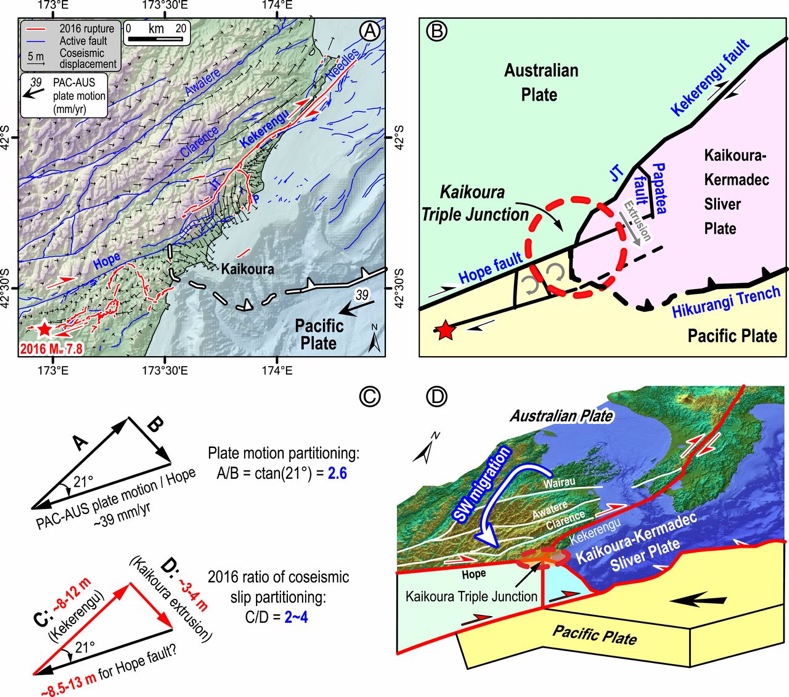Editor: 邵丹蕾 Author: SHI Xuhua Time: 2019-12-23 Number of visits :137
Deciphering complex rupture behaviors of great earthquakes and associated driving mechanisms is critical to relieving seismic/geological hazards and understanding geodynamics of specific regions. This scientific issue is particularly important to the twin islands of New Zealand. This region shows frequent volcanic and earthquakes activities, including the 2016 Kaikoura earthquake with moment magnitude (Mw) of 7.8 (Fig. 1), one of most complex earthquakes ever observed on the Earth. This earthquake rupture occurred along more than 20 faults with variable orientations and shear senses (Fig. 2). However, the driving mechanisms for such a complex earthquake rupture remains unclear.

Fig. 1. The map showing active faults, volcanoes, and seismicity in the northern and central New Zealand. Light blue lines delineate locations of boundaries between 3 main plates, Pacific, Australian, and Tonga–Kermadec–Kaikoura [TKK] sliver plate. The dashed red circle is the Kaikoura Triple Junction (KTJ), as proposed in this study. Data sources: active faults (Litchfield et al., 2014; Langridge et al., 2016); 250-m-resolution bathymetry data (Mitchell et al., 2012); topography (Farr et al., 2007); seismicity (GNS Science [2016] and https://earthquake.usgs.gov/earthquakes/search/); and volcanoes (Smithsonian Institution, 2018). Figure source: Shi et al. (2019).
In a new paper by Shi et al. (2019), published in the Proceedings of the National Academy of Sciences of the United States of America (https://doi.org/10.1073/pnas.1916770116), Dr. SHI Xuhua, a ZJU100 Young Professor of the Zhejiang University, Dr. Paul Tapponnier, a distinguished research professor of China Earthquake Administration, and other co-authors, found that the Kaikoura region in central New Zealand likely hosts a triple junction, namely the Kaikoura Triple Junction (KTJ) (Figs. 1 and 2). This triple junction connects three tectonic plates, the Pacific plate, the Australian plate and a sliver plate (Tonga-Kermadec-Kaikoura [TKK] plate), and also connects three fastest-slipping faults of New Zealand, the Hope, JT-Kekerengu-Needles, and the Hikurangi megathrust faults. This inference was obtained based on analyses of the partitioning of the coseismic slip during the 2016 Kaikoura earthquake event and the plate motion around Kaikoura, the large-scale fault kinematics, volcanism, seismicity, and slab geometry in the broader Tonga–Kermadec-Kaikoura region. The study suggests the KTJ has migrated southwestwards since its birth, driving the southward propagation of the volcanism of the North Island, the stepping of the Marlborough fault system in the northeastern South Island, and the complex rupture of the 2016 Kaikoura earthquake. This study illuminates a new way for exploring driving mechanisms responsible for complex earthquake ruptures occurring along plate boundaries.

Fig. 2. Plots show comparable coseismic slip of the 2016 Kaikoura earthquake and plate-motion partitioning, which suggest that the JT–Kekerengu–Needles fault is a plate-boundary fault. (A) InSAR-derived velocity vectors (Wang et al., 2018). Data sources are as in Fig. 1. (B) Simplified map of the KTJ showing the intersecting point for the nearly connected JT–Kekerengu, Hope, and Hikurangi faults, at the southern end of the TKK sliver plate. (C) Triangular vectors of plate-motion partitioning and the 2016 coseismic slip vectors on three main faults. (D) 3-D view of the KTJ. Data sources are the same as in Fig. 1. Figure source: Shi et al. (2019).
Reference
Farr, T. G., Rosen, P. A., Caro, E., et al., 2007, The Shuttle Radar Topography Mission: Reviews of Geophysics, 45(2), RG2004.
GNS Science, 2016, “Where were New Zealand’s largest earthquakes?”, https://www.gns.cri.nz/Home/Learning/Science-Topics/Earthquakes/New-Zealand-Earthquakes/Where-were-NZs-largest-earthquakes. Accessed 24 November 2016.
Langridge, R., Ries, W., Litchfield, N. et al., 2016, The New Zealand active faults database. New Zealand Journal of Geology and Geophysics, 59(1), 86–96.
Litchfield, N., Van Dissen, R., Sutherland, et a., 2014, A model of active faulting in New Zealand: New Zealand Journal of Geology and Geophysics, 57(1), 32-56.
Mitchell, J. S., Mackay, K. A., Neil, H. L. J et al., 2012, Undersea New Zealand, 1: 5,000,000 National Institute of Water and Atmospheric Research Chart, Miscellaneous Series No. 92.
Shi, X., Tapponnier, P., Wang, T., Wei, S., Wang, Y., Wang, X., and Jiao, L., 2019, Triple junction kinematics accounts for the 2016 Mw 7.8 Kaikoura earthquake rupture complexity, Proceedings of the National Academy of Sciences, https://doi.org/10.1073/pnas.1916770116
Smithsonian Institution, Global Volcanism Program (2018). https://volcano.si.edu/. Accessed 30 July 2018.
Wang, T., Wei, S., Shi, X., et al., 2018, The 2016 Kaikōura earthquake: Simultaneous rupture of the subduction interface and overlying faults, Earth and Planetary Science Letters, 482, 44-51.
